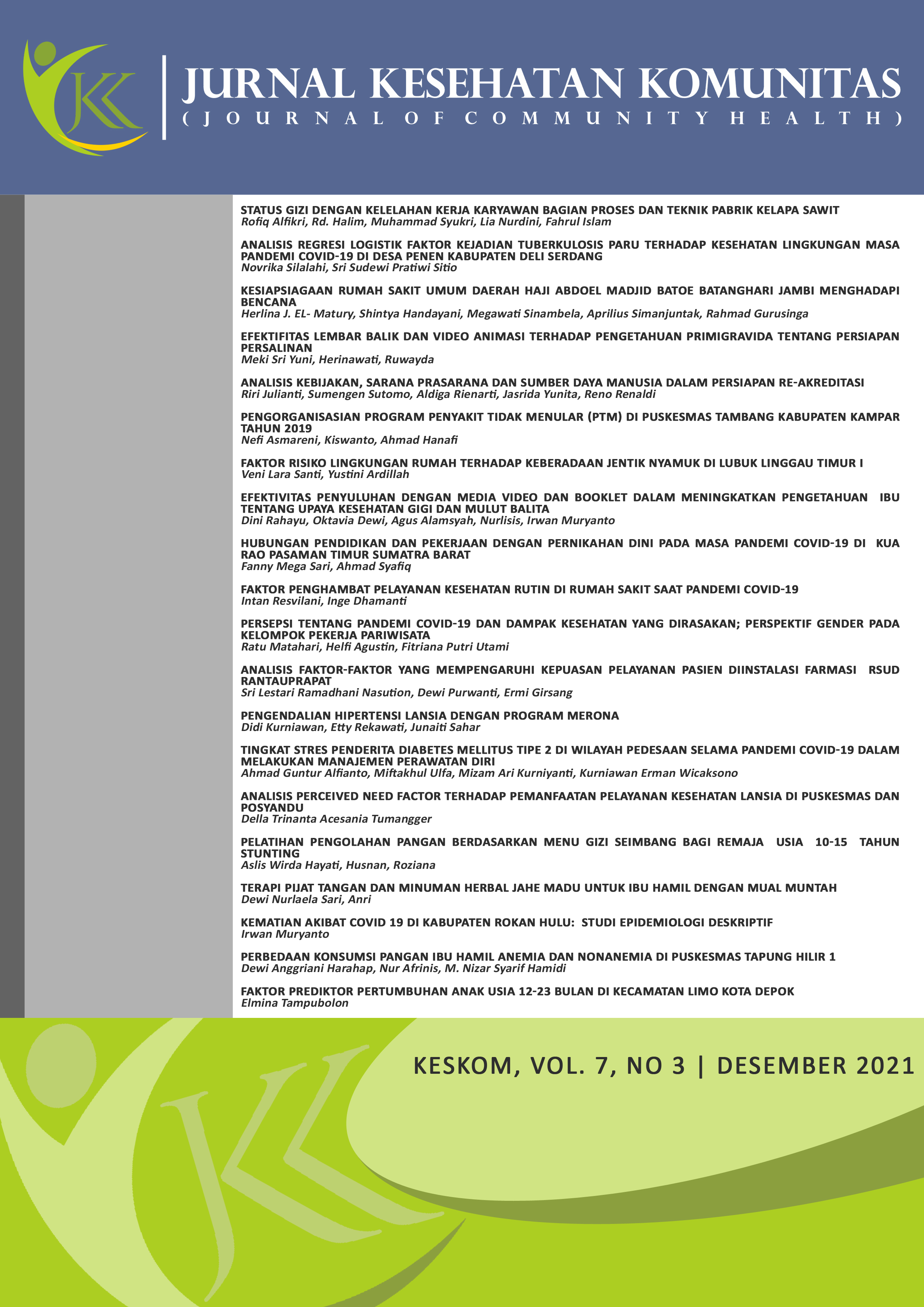The Different of Food Consumption of Anemia And Non-Anemia Pregnant Women in Puskesmas Tapung Hilir 1 Kampar
DOI:
https://doi.org/10.25311/keskom.Vol7.Iss3.1015Keywords:
Anemia, energy, protein, carbohydrate, ironAbstract
Anemia in pregnant women occurs due to a lack of food consumption in pregnant women, especially iron consumption. Hemorrhage postpartum is the main cause of maternal death due to anemia in pregnancy. The purpose of this study was to determine the differences in food consumption among pregnant women who are anemic and non-anemic in the working area of ​​the Tapung Hilir 1 Public Health Center, Kampar Regency. This type of research is quantitative with a case-control design. The sample of this research consists of 30 non-anemic pregnant and 30 anemia pregnant. The research instrument used a questionnaire and a food recall form 2x24 hours. Data collection techniques used were interviews. 24-hour food recall data were obtained for 2 non-consecutive days. The results of the analysis of the average energy consumption (47.37 kcal), protein (78.43 gr), carbohydrate (44.93 g), and iron consumption (17.37 mg). Analysis using the Mann Whitney test found differences in energy consumption, carbohydrates, Fe (p = 0.000) in anemic and non-anemic pregnant women, and there was no difference in protein consumption (p = 0.344) in anemic and non-anemic pregnant women It is expected that pregnant women can increase food consumption that can prevent anemia in pregnancy such as consumption of animal protein, iron, and vitamin C.
Downloads
References
Angrainy Rizka (2017) ‘Hubungan pengetahuan dengan sikap ibu hamil dalam pencegahan anemia di puskesmas rumbai’, Journal Endurance, 2(February), pp. 62–67.
Argana, G., Kusharisupeni and Utari, D. M. (2004) ‘Vitamin C Sebagai Faktor Dominan Untuk Kadar Hemoglobin Pada Wanita Usia 20-35 Tahun’, Jurnal Kedokteran Trisakti, 23(1), pp. 6–14.
Arisman, M. (2004) Gizi Dalam Daur Kehidupan. Jakarta: EGC Jakarta.
Astuti, D. and Kalsum, U. (2018) ‘Pola Makan dan Umur Kehamilan Trimester III dengan Anemia pada Ibu Hamil’, Indonesia Jurnal Kebidanan, 2(1), pp. 24–30.
Ayensu, J. et al. (2020) ‘Prevalence of anaemia and low intake of dietary nutrients in pregnant women living in rural and urban areas in the Ashanti region of Ghana’, PLoS ONE, 15(1), pp. 1–15. doi: 10.1371/journal.pone.0226026.
Christianti, D. F., Anwar, F. and Dwiriani, C. M. (2019) ‘Keragaman Konsumsi Pangan dan Kejadian Anemia pada Ibu Hamil di Kabupaten Sumenep Madura Dietary Diversity and Anemia of Pregnant Women in Sumenep District Madura’, Jurnal MKMI, 15(2), pp. 168–177. Available at: https://journal.unhas.ac.id/index.php/mkmi/article/view/6321/pdf.
Fathonah, S. (2016) Gizi & Kesehatan untuk Ibu Hamil. Jakarta: Erlangga.
Fikawati, S., Syafiq, A. and Karima, K. (2015) Gizi Ibu dan Bayi. Jakarta: Rajawali Press.
Kementerian Kesehatan (2018) Profil Kesehatan Indonesia 2018.
Krafft, A., Murray-Kolb, L. and Milman, N. (2012) ‘Anemia and iron deficiency in pregnancy’, Journal of Pregnancy, 2012. doi: 10.1155/2012/241869.
Lee, A. I. and Okam, M. M. (2011) ‘Anemia in Pregnancy’, Hematology/Oncology Clinics of North America, 25(2), pp. 241–259. doi: 10.1016/j.hoc.2011.02.001.
Manuaba (2005) Ilmu Kebidanan, Penyakit Kandungan dan Keluarga Berencana. Jakarta: EGC Jakarta.
Mardiah, A. et al. (2018) ‘Perbedaan Kadar Brain Derived Neurotropic Factor Neonatus Dari Ibu Hamil Normal Dan Anemia Defisiensi Besi’, Jurnal Endurance, 3(3), p. 568. doi: 10.22216/jen.v3i3.3706.
Mireku, M. O. et al. (2016) ‘Prenatal iron deficiency, neonatal ferritin, and infant cognitive function’, Pediatrics, 138(6). doi: 10.1542/peds.2016-1319.
Proverawati, A. and Wati, E. K. (2011) Ilmu Gizi untuk Keperawatan dan Gizi Kesehatan. Yogjakarta: Nuha Medika.
Rahmaniar, A., Taslim, N. a and Baharuddin, B. (2013) ‘Faktor-faktor yang berhubungan dengan kekurangan energi kronis pada ibu hamil di Tampa Padang Kabupaten Mamuju, Sulawesi Barat’, Media Gizi Masyarakat Indonesia, 2, pp. 98–103.
Samuel, S. et al. (2020) ‘Socio-economic and dietary diversity characteristics are associated with anemia among pregnant women attending antenatal care services in public health centers of Kembata Tembaro Zone, Southern Ethiopia’, Food Science and Nutrition, 8(4), pp. 1978–1986. doi: 10.1002/fsn3.1485.
Setyawati, B. and Syauqy, A. (2014) ‘Perbedaan Asupan Protein, Zat Besi, Asam Folat, dan Vitamin B12 Antara Ibu Hamil Trimester III Anemia dan Tidak Anemia di Puskesmas Tanggungharjo Kabupaten Grobongan’, Journal of Nutrition College, 3, pp. 228–234.
Tadesse, S. E. et al. (2017) ‘Determinants of anemia among pregnant mothers attending antenatal care in Dessie town health facilities, northern central Ethiopia, unmatched case -control study’, PLoS ONE, 12(3), pp. 1–9. doi: 10.1371/journal.pone.0173173.
Yuliati, H., Widajanti, L. and Ronny, A. (2017) ‘Vitamin C dan Suplemen Tablet Besi dengan Kadar Ibu Hamil Trimester II dan III ( di Wilayah Kerja Puskesmas Purwanegara 2 Kabupaten Banjarnegara)’, 5, pp. 675–682
Downloads
Submitted
Accepted
Published
How to Cite
Issue
Section
License
Copyright (c) 2021 Jurnal Kesehatan Komunitas

This work is licensed under a Creative Commons Attribution-NonCommercial-ShareAlike 4.0 International License.
Copyright @2017. This is an open-access article distributed under the terms of the Creative Commons Attribution-NonCommercial-ShareAlike 4.0 International License (http://creativecommons.org/licenses/by-nc-sa/4.0/) which permits unrestricted non-commercial used, distribution and reproduction in any medium












































